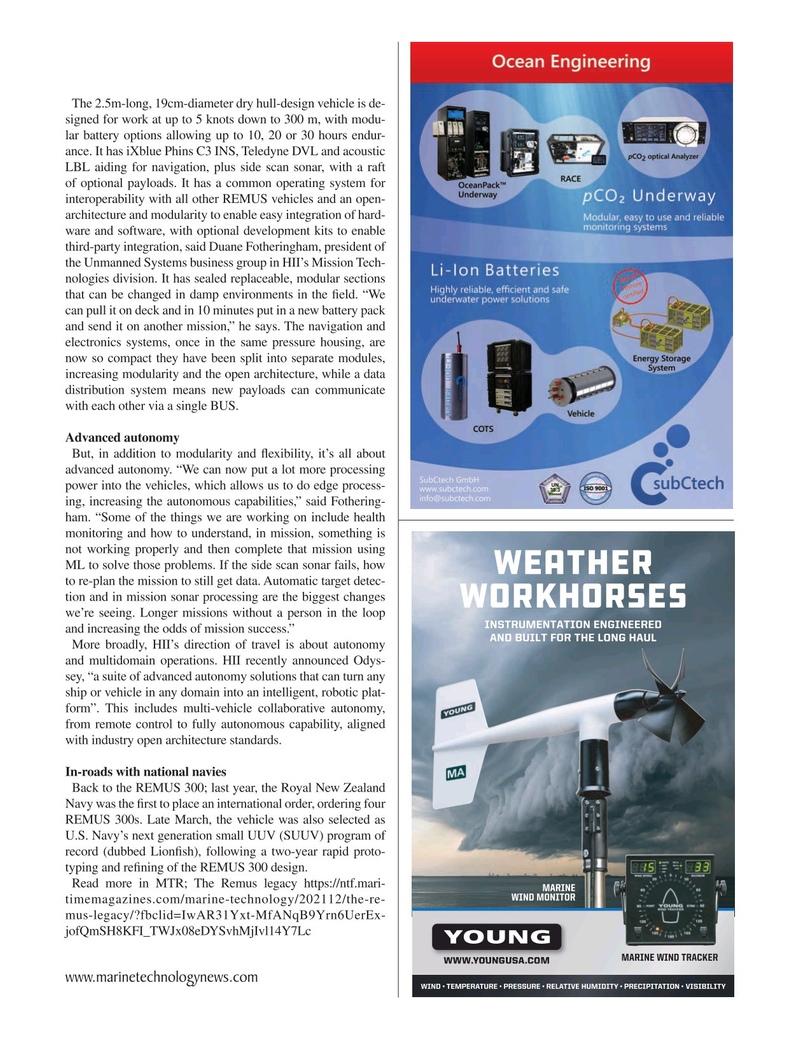
Page 47: of Marine Technology Magazine (May 2022)
Read this page in Pdf, Flash or Html5 edition of May 2022 Marine Technology Magazine
The 2.5m-long, 19cm-diameter dry hull-design vehicle is de- signed for work at up to 5 knots down to 300 m, with modu- lar battery options allowing up to 10, 20 or 30 hours endur- ance. It has iXblue Phins C3 INS, Teledyne DVL and acoustic
LBL aiding for navigation, plus side scan sonar, with a raft of optional payloads. It has a common operating system for interoperability with all other REMUS vehicles and an open- architecture and modularity to enable easy integration of hard- ware and software, with optional development kits to enable third-party integration, said Duane Fotheringham, president of the Unmanned Systems business group in HII’s Mission Tech- nologies division. It has sealed replaceable, modular sections that can be changed in damp environments in the ? eld. “We can pull it on deck and in 10 minutes put in a new battery pack and send it on another mission,” he says. The navigation and electronics systems, once in the same pressure housing, are now so compact they have been split into separate modules, increasing modularity and the open architecture, while a data distribution system means new payloads can communicate with each other via a single BUS.
Advanced autonomy
But, in addition to modularity and ? exibility, it’s all about advanced autonomy. “We can now put a lot more processing power into the vehicles, which allows us to do edge process- ing, increasing the autonomous capabilities,” said Fothering- ham. “Some of the things we are working on include health monitoring and how to understand, in mission, something is not working properly and then complete that mission using
ML to solve those problems. If the side scan sonar fails, how to re-plan the mission to still get data. Automatic target detec- tion and in mission sonar processing are the biggest changes we’re seeing. Longer missions without a person in the loop and increasing the odds of mission success.”
More broadly, HII’s direction of travel is about autonomy and multidomain operations. HII recently announced Odys- sey, “a suite of advanced autonomy solutions that can turn any ship or vehicle in any domain into an intelligent, robotic plat- form”. This includes multi-vehicle collaborative autonomy, from remote control to fully autonomous capability, aligned with industry open architecture standards.
In-roads with national navies
Back to the REMUS 300; last year, the Royal New Zealand
Navy was the ? rst to place an international order, ordering four
REMUS 300s. Late March, the vehicle was also selected as
U.S. Navy’s next generation small UUV (SUUV) program of record (dubbed Lion? sh), following a two-year rapid proto- typing and re? ning of the REMUS 300 design.
Read more in MTR; The Remus legacy https://ntf.mari- timemagazines.com/marine-technology/202112/the-re- mus-legacy/?fbclid=IwAR31Yxt-MfANqB9Yrn6UerEx- jofQmSH8KFI_TWJx08eDYSvhMjIvl14Y7Lc www.marinetechnologynews.com
MTR #4 (34-49).indd 47 4/29/2022 2:58:31 PM

 46
46

 48
48
